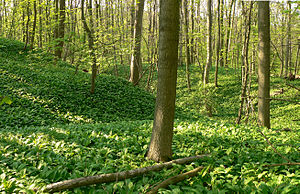Herlingsberg War
| date | 1291 to 1292 |
|---|---|
| place | Harliburg and the surrounding area |
| output | Destruction of the castle |
| Parties to the conflict | |
|---|---|
|
Siegfried II of Querfurt |
|
In the 1290s, the Herlingsberg War was an armed conflict between the Hildesheim Monastery and Duke Heinrich the Wonderful, each with allies.
prehistory
Heinrich the Whimsical owned the Harli Castle . The castle crew was blamed for the poor safety of the road between Goslar and Hildesheim . Therefore, under Bishop Siegfried II of Querfurt , the Hildesheim side demanded the handover or sale of the castle and, after Heinrich's refusal, turned to the regional provincial estates for support, referring to the land peace agreed in Erfurt in 1290 .
procedure
The attack on Harliburg began in May 1291. At first she held out. On August 7th, apart from Bishop Siegfried II, Erich von Brandenburg , Albrecht II (Braunschweig-Wolfenbüttel-Göttingen) , Wilhelm I (Braunschweig) , Count von Falkenstein (Harzgrafen) and numerous knights took up positions in front of the castle, divided among five Camp. To relieve the castle, Heinrich the Wonderful brought in troops from Landgraviate Thuringia , Bishopric Meißen , Landgraviate Hesse , Archbishopric and Duchy of Bremen and Bishopric and Duchy of Verden . The relief failed and Duke Heinrich was beaten on August 16, there were numerous victims and prisoners. The Harliburg was conquered on August 17th.
consequences
The Harliburg was razed . Bishop Siegfried II moved in the ducal court of Bocla and had the Liebenburg built. A little later, Heinrich the Wonderful and Albrecht II conquered the Liebenburg. Then Bishop Siegfried II put together a large association to relieve the castle. Therefore, Heinrich and Albrecht II fled leaving their weapons behind. For their part, they raised new troops and had Löwental Castle built in Ölsburg . As a counter-castle, Bishop Siegfried II immediately had the Papenburg built nearby. He occupied this with such a strong team that the Löwental Castle could finally be taken. The bishop had the two new castles demolished again. In the same year Otto II (Braunschweig-Lüneburg) had Calenberg Castle expanded into a fortress. The bishop saw the place as belonging to the Hildesheim monastery and besieged the castle. Otto II gathered a large army to which u. a. Heinrich der Wunderliche, Albrecht II., Otto IV. (Brandenburg) , Hermann belonged. The army conquered the fortresses in Oberg and Stederdorf and attacked the bishopric from there. For his part, Bishop Siegfried II put together an army, this time consisting of mercenaries and squires. There were several skirmishes in which he was victorious. The army of the bishopric now undertook campaigns in enemy territory. They conquered the fortresses of the dukes in Uslar , Gieboldehausen and Echte . Ultimately, Albrecht II and Otto II made peace with Siegfried II. It was agreed to destroy the fortresses Oberg and Stederdorf and to preserve Calenberg Castle. Henry the Wonderful, however, continued his campaign and had the Mosburg built near the Bocla court. The bishop conquered and destroyed this castle, as well as the castle of those of Werder , who were allied with Heinrich. He also had Schladen Castle, allied with Heinrich, besieged and bought the castle in Wallmoden for 950 marks to use as a counter-castle to Lutter Castle . So Heinrich the Wonderful had to give way to peace.
Herlingsberga
Heinrich Rosla , a witness to the events, presumably a monk of the Walkenried monastery , wrote a Latin epic of Homeric pathos in 477 hexameters , which was later titled Herlingsberga , soon after the fighting .
literature
- Hermann A. Lüntzel: History of the diocese and city of Hildesheim. Issued from his estate. Part 2. Gerstenberg, Hildesheim 1858, pp. 275-277 .
- Otto von Heinemann : History of Braunschweig and Hanover. Volume 2, Book 1: The Duchy of Braunschweig-Lüneburg and its first partitions. Section 3: The older house in Braunschweig. Albrecht I and his sons. Perthes, Gotha 1886, p. 44 ff.
- Friedrich Steger : Albrecht the Feiste. In: Friedrich Steger (Ed.): The House of the Welfs. Contributions to the history of the states of Braunschweig and Hanover in biographies of the distinguished regents and princes of both Welf lines. Oehme and Müller, Braunschweig 1843, pp. 56–66, here p. 58 .
Individual evidence
- ↑ First printing in 1652 by Johann Heinrich Meibom ( digitized version )
